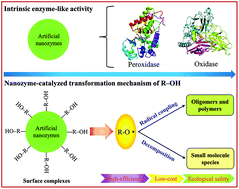Metal and metal-oxide nanozymes: bioenzymatic characteristics, catalytic mechanism, and eco-environmental applications
Abstract
Phenolic contaminants (R-OH) are a category of highly toxic organic compounds that are widespread in aquatic ecosystems and can induce carcinogenic risk to wildlife and humans; natural enzymes as green catalysts are capable of step-polymerizing these compounds to produce diverse macromolecular self-coupling products via radical-mediated C–C and C–O–C bonding at either the ortho- or para-carbon position, thereby evading the bioavailability and ecotoxicity of these compounds. Intriguingly, certain artificial metal and metal-oxide nanomaterials are known as nanozymes. They not only possess the unique properties of nanomaterials but also display intrinsic enzyme-mimicking activities. These artificial nanozymes are expected to surmount the shortcomings, such as low stability, easy inactivation, difficult recycling, and high cost, of natural enzymes, thus contributing to eco-environmental restoration. This review highlights the available studies on the enzymatic characteristics and catalytic mechanisms of natural enzymes and artificial metal and metal-oxide nanozymes in the removal and transformation of R-OH. These advances will provide key research directions beneficial to the multifunctional applications of artificial nanozymes in aquatic ecosystems.

- This article is part of the themed collection: Recent Review Articles


 Please wait while we load your content...
Please wait while we load your content...